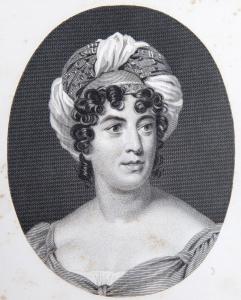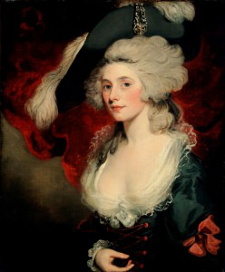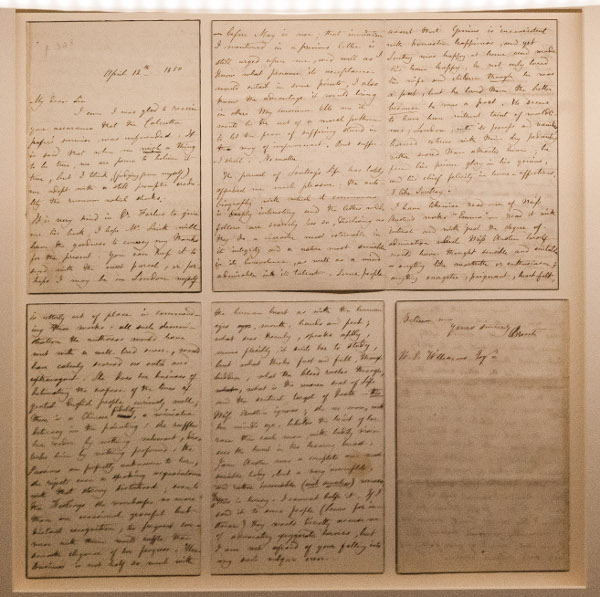SINCE OPENING IN 2003, CHAWTON HOUSE LIBRARY has championed individual and collaborative research on early women’s writing of the period 1600-1830, and on Jane Austen herself. We have also welcomed group tours and visits by schools, and hosted a wide variety of talks, workshops, and conferences. In response to the growing demand from the visiting public, we opened, in March 2015, to people who wanted to visit at their own pace and to see what Chawton House Library had to offer, both in terms of the historic property itself—the Elizabethan Manor that belonged to Jane Austen’s brother Edward—and in terms of the library collection. In 2016—following several generous grants to purchase new climate-controlled display cases for our books—we were able to curate our first major exhibition, focusing on Jane Austen’s Emma in its bicentenary year: Jane Austen’s Emma at 200: From English Village to Global Appeal (21 March through 25 September 2016).
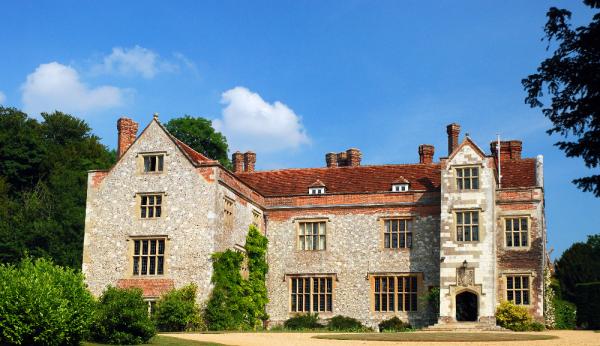
Chawton House Library
In this exhibition, the three or four families in a country village of Emma were given a broad contextual setting. I increasingly felt that through the lens of Emma, all aspects of Regency-Period literature, culture and society could be effectively explored: the marker, perhaps, of a truly great novel. Certainly, some of the characters in the novel do travel—to and from Bath and Bristol, for example, and, famously, to London for a haircut! The reader, however, never truly follows them to these places. But the exhibition had an unapologetically broad scope, beyond Hartfield and Highbury, beyond even London and Dublin. The visitor travelled virtually from the booksellers’ shelves of Paris and Philadelphia, to “Swisserland” and Sweden in the footsteps of Austen’s own brothers. We explored the plays performed by the children of the French aristocracy as well as appropriate reading material for the upper middling sort in Bath.
Turning to the literary marketplace in the Regency Period, the career of publisher John Murray II—“a Rogue of course, but a civil one” as Austen put it when she was negotiating the publication of Emma (17-18 October 1815)—took us further afield, via the other women writers he published. From the seventeenth-century court of Versailles to Germany, Paris, Athens, Perth and Edinburgh in Scotland, and the streets of Rio de Janeiro, Murray’s female friends demonstrate a remarkable diversity that gives the lie to a literary marketplace inextricably dominated by pictures of “lady” novelists, confined to rural sitting rooms with creaking doors. In our largest display cabinet, I set Jane Austen’s engagement with Shakespeare in Emma alongside eighteenth-century women’s growing appreciation of “England’s Bard.” This juxtaposition proved a remarkably productive way of viewing engagement with Shakespeare’s plays as much more than the invention of Garrick, 400 years since Shakespeare’s death. Finally, one northern English woman novelist—celebrating her 200th birthday—muscled up to her southern counterpart: Charlotte Brontë’s comments on Emma are extremely well-known, but the beautiful material object that is her 1850 letter had a charm all of its own.
Now, I invite you to take a virtual tour of all exhibits in the Chawton House Library Emma at 200 exhibition. Interpretation boards in each room set the scene for the items in each display case, using quotations from Emma, from Jane Austen’s own letters, and from her readers in 1816 and throughout the nineteenth and twentieth centuries. What cannot be adequately reproduced in this online exhibition is the sense of place, the evocative nature of strolling through the rooms that Jane Austen knew, and which surely must have inspired her creation of the great houses of her novels. Michael Caines, reviewing the exhibition, put it nicely when he wrote that this was
an exhibition that mainly consists of books, open and closed, and manuscripts, placed around the house so that the visitor enjoys them diluted, as it were, by the marvellous visual variety of the oil paintings and other artefacts on permanent display there: a portrait of Kitty Fisher the courtesan in a corridor, say; scions of the Knight family in the gallery; a suit belonging to Edward Austen Knight in the dining room.
I hope you enjoy this visit, and I invite you to start with me, in the Great Hall, as we think about Emma at 200 and the novel’s move from an English village to its global appeal.
In the Great Hall
From Chawton to Paris and Philadelphia: Emma’s global reach
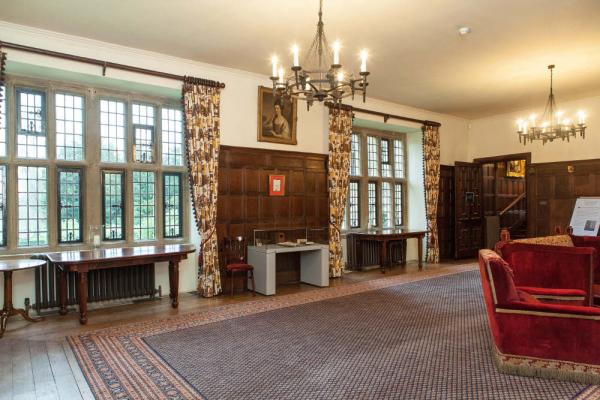
You are now collecting your People delightfully, getting them exactly into such a spot as is the delight of my life;—3 or 4 Families in a Country Village is the very thing to work on—& I hope you will write a great deal more, & make full use of them while they are so very favourably arranged.
—Jane Austen to her niece Anna Austen, from Chawton, 9-18 September 1814.
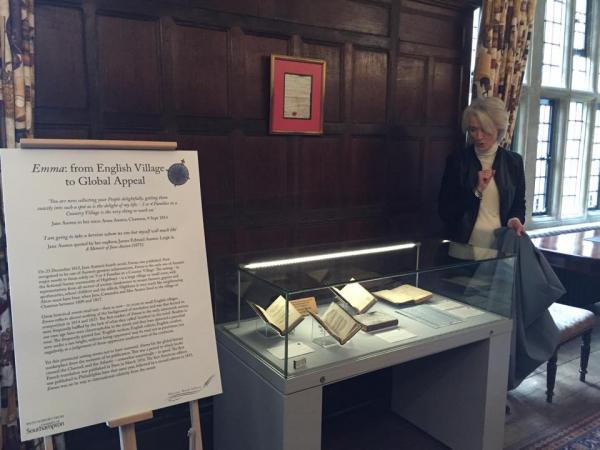
On 23 December 1815, Jane Austen’s fourth novel, Emma, was published. Now recognized as one of Austen’s greatest achievements in fiction, Emma is the only one of Austen’s major novels to focus solely on “3 or 4 Families in a Country Village.” The setting—in the fictional Surrey community of Highbury—is a large village or small town, with representatives from all sectors of society: landowners to tenant farmers, gypsies and apothecaries, school children and the elderly. Highbury is very much like neighboring Alton must have been when Jane, Cassandra, and Mrs. Austen lived in the village of Chawton between 1809 and 1817.
Great historical events tend not—then as now—to occur in small English villages. Emma reflects almost nothing of the background of revolution and war that framed its composition in 1814 and 1815. The first readers of Emma in the early nineteenth century were frequently baffled by the lack of what they called “incident” in the novel. Readers in our own age have seen claustrophobia in Emma, and they have detected a parochial tone. The frequently quoted line “English verdure, English culture, English comfort, seen under a sun bright, without being oppressive” (391) may be read not as patriotism, but negatively, as a judgment of those oppressive southern suns of the continent.
Yet this provincial setting seems not to have mattered. Emma hit the global literary marketplace from the moment of its publication. This was a period in which books crossed the Channel, and the Atlantic, at speed. The first French translation was published in Paris in March 1816. The first American edition was published in Philadelphia later that same year, followed by a second edition in 1833. Emma was on its way to international celebrity from the outset.
La Nouvelle Emma, ou les Caractères anglais du siècle. Paris: Arthus Bertrand, 1816. (On loan from the University of Göttingen Library, Germany.)
This rare copy of the first French translation was published in Paris in March 1816 by bookseller Arthus Bertrand. The preface is lengthy: this book, a French reader would have read in the first sentence, is not, strictly speaking, a novel. It is rather a tableau of English provincial life that those French people who have travelled to the country will recognise as accurate. The anonymous translator changed some of the text to suit the French readers: Knightley’s slight on the “amiable” French (160) becomes a slight on the Italians. The popularity of fiction in French throughout Europe in the nineteenth century explains this translation’s current home in Germany.
Emma: A Novel, Three Volumes in Two. Philadelphia: by M. Carey, 1816. (On loan from King’s College, Cambridge.)
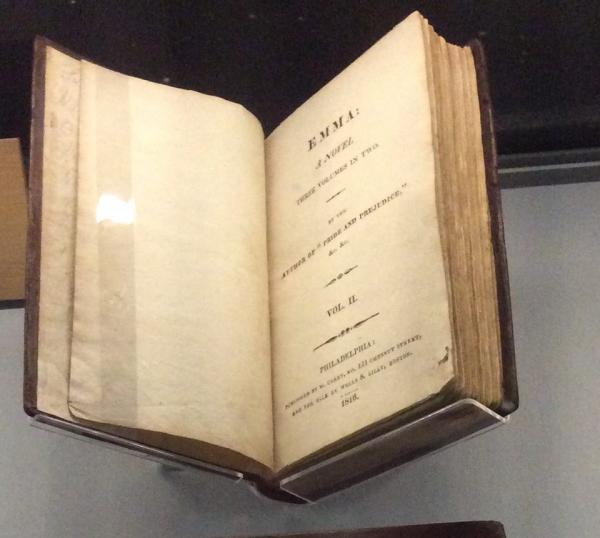
This extremely rare first American edition of Emma was the first of Austen’s works to be published in the New World. It probably appeared in the Summer or Autumn of 1816. The original English editions were available from booksellers in the United States. The copy on display here belonged to the late Austen scholar David J. Gilson. As Gilson puts it in his Bibliography, “JA’s scattered letter references to her novels include no mention of any foreign editions, so that, as far as we can tell, she was unaware that one of them was published in the United States of America during her lifetime” (97).
Emma: A Novel in Two Volumes, by Miss Austen, author of Pride and Prejudice, Mansfield Park, Persuasion, &c., &c. Philadelphia: Carey, Lea and Blanchard, 1833. (Chawton House Library Collection, donated by Matthew J. Bruccoli.)
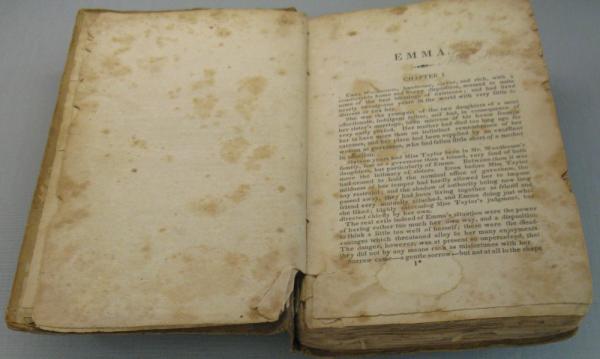
This second American edition, in its original boards, includes “Miss Austen’s” own name on the title page. It belonged to Matthew J. Bruccoli’s wife Arlyn; her name is inscribed on the first page. As with the first American edition, there are changes—both major and minor—from the original text.
Letter from David J. Gilson to Matthew J. Bruccoli, 11 October 1967. (Chawton House Library Collection, donated by Matthew J. Bruccoli.)
This letter from scholar David Gilson to Matthew J. Bruccoli, Columbus, Ohio, provides some documentation about Gilson’s ongoing search for the rare first American edition of Austen’s Emma. By the time Gilson’s bibliography was published in 1982, he had located a total of three copies, and carried out a remarkable amount of painstaking work to track down prices and sales in the US. In 1818, a list of books sold by Philadelphia bookseller Carey documents the sale of the 1816 Philadelphia edition of Emma for $2.50, bound, or for $2, in boards. The English edition could also be bought from Carey: the price, $4.
In the Dining Room
Scenes from Swisserland and the lure of the Continent
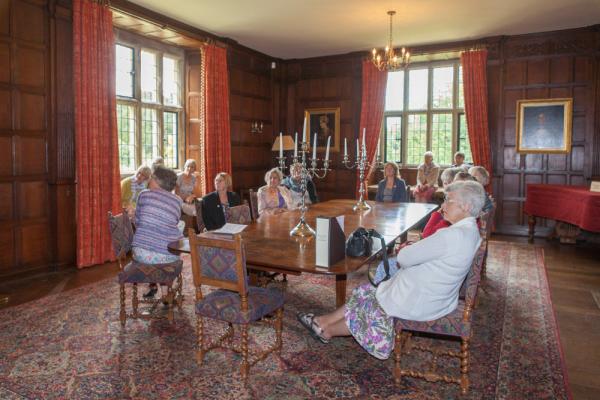
Behold me going to write you as handsome a Letter as I can. . . . It must be a real enjoyment to you, since you are obliged to leave England, to be where you are, seeing something of a new Country, & one that has been so distinguished as Sweden.— . . . I have a great respect for former Sweden. So zealous as it was for Protestanism!— . . . And I have always fancied it more like England than many Countries. . . . We had some fine dry weather . . . , which was very acceptable to the Holders of Hay & the Masters of Meadows.— . . . Edward has got in all his, in excellent order. . . . Edward is very well & enjoys himself as thoroughly as any Hampshire born Austen can desire. . . . We are in hopes of another visit from our own true, lawful Henry very soon. . . . The scheme for Scotland we think an excellent one both for himself & his nephew. . . . Charles’s little girls were with us about a month, & had so endeared themselves that we were quite sorry to have them go. . . . They are all now at Southend together.—Why do I mention that?—As if Charles did not write himself.— . . . I hope you continue beautiful & brush your hair, but not all off.—We join in an infinity of Love.—Yrs very affectly.
—Jane Austen to her brother Frank, Chawton, 3-6 July 1813
Austen’s exuberant, chatty letter of July 1813 to brother Frank gives a sense of the place of her brothers in her life. Although she travelled little herself, her brothers’ travels—as part of their naval duties, or on the Grand Tour, or indeed in high society in London—served as inspiration, and indeed for satire.
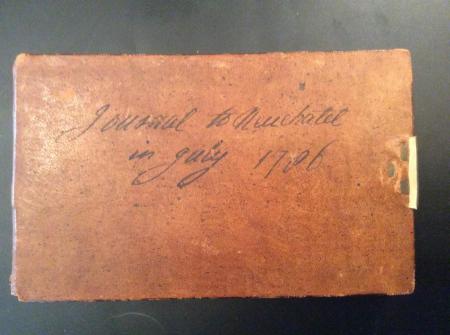 |
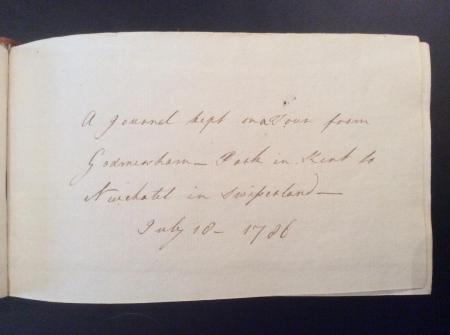 |
It has been suggested that the character of the landowning Mr. Knightley in Emma may have been inspired by Edward, who took the name Knight in 1812 as a condition of his inheritance of the estate here at Chawton and of Godmersham Park in Kent. Frank Churchill—with his desire to travel to “Swisserland” (396)—may have been inspired by both the travels of brothers Frank and Charles, and by Edward’s “Grand Tour” journey to Neuchatel in 1786. Although, in Emma, the heroine exclaims that to be “‘sick of England’” is to be “‘sick of prosperity and indulgence’” (396), we learn through the novel not to privilege her view. The continent clearly holds some attractions.
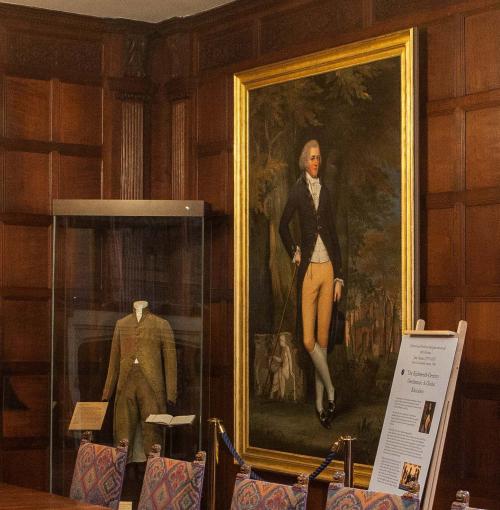
Edward Austen (later Edward Austen Knight)
In the Tapestry Gallery
 Very good lists: Reading in Emma
Very good lists: Reading in Emma
Emma has been meaning to read more ever since she was twelve years old. I have seen a great many lists of her drawing up at various times of books that she meant to read regularly through—and very good lists they were—very well chosen, and very neatly arranged—sometimes alphabetically, and sometimes by some other rule. The list she drew up when only fourteen—I remember thinking it did her judgment so much credit, that I preserved it some time. . . . But I have done with expecting any course of steady reading from Emma. She will never submit to any thing requiring industry and patience, and a subjection of the fancy to the understanding.”
—Mr. Knightley, Emma (37)
What was a “course of steady reading” to consist of for Austen's contemporaries and her fictional heroes and heroines? Certainly—and as Mr. Knightley’s comments suggest—simply drawing up an appropriate list would not suffice. Indeed, many late eighteenth and early nineteenth-century novels employ the device of a warning from the narrator, directed at their female reader: beware of the dangers of fiction, the young woman is told, it enflames the mind and leads to romantic flights of fancy. Reading for self-improvement and education is essential.
In Emma, the education of the young heroine is in many ways an exercise in her learning to read, both literally and figuratively. Many works that are now long-forgotten are mentioned in the course of the novel, several of which are on display here.
What characters actually read (or, in the case of Robert Martin, what they fail to read) can even serve as a device that informs Austen’s intricate plot. Misreadings about Harriet, Mr. Martin, and Mr. Elton, along with the misunderstanding about Frank Churchill’s feelings, and the nature of his relationship with Jane Fairfax, threaten to ruin Harriet’s happiness as well as Emma’s own. But Austen gives us the satisfaction of a happy ending. Emma herself moves from a misreading of many characters and situations in Hartfield and Highbury to reading correctly, with Knightley’s guidance and help.
Stéphanie-Félicité de Genlis, Adelaide and Theodore; or Letters on Education. First edition of the English translation. London: Printed for C. Bathurst and T. Cadell, 1783. (Chawton House Library Collection.)
Emma Woodhouse refers to Genlis’s Adelaide and Theodore directly. On the birth of a daughter to her former governess Mrs. Weston, Emma points out that “‘her own little Adelaide,’” will be “‘educated on a more perfect plan’” than she was, since Mrs. Weston has had a chance to practice (503)!
Genlis’s epistolary novel, first published in French in 1782 as Adèle et Théodore, was a bestseller in the 1780s and 1790s. It provides three different “plans” of education—for Princes, for boys, and for girls. The lengthy and challenging “Course of Reading” sets out exactly what a young girl should read and at what age. The first English translation was carried out by a group of women, “Mrs. Watson of Essex and her daughters (of Norman House, Stansted)”: they are identified in a copy held in the collection here. Edward Austen, later Knight’s, collection at Godmersham Park in Kent contained a copy of Adèle et Théodore in French.
Stéphanie-Félicité de Genlis. Theâtre à l’usage des jeunes personnes. Londres: Chez Wilkie et Robinson &c, 1813. (Chawton House Library Collection, donated by Sandra Clark.)
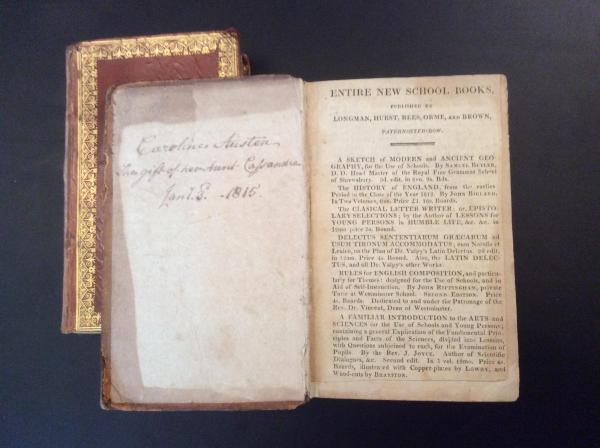
Genlis’s works were popular with several generations of British children. Her Theâtre à l’usage des jeunes personnes, first published in 1779, was translated into several European languages, including English, in the 1780s and 1790s. The work comprises short, moral plays for children, to be performed in private houses.
This French edition was a gift to Caroline Austen, daughter of James Austen, from her aunt and godmother Cassandra Austen. On 13 March 1816, Aunt Jane wrote to Caroline on another of Genlis’s works for children, Les Veillées du Château: “You seem to be quite my own Neice in your feelings towards Mde de Genlis. I do not think I could even now, at my sedate time of Life, read Olimpe et Theophile without being in a rage.” Genlis’s works were clearly not read uncritically.
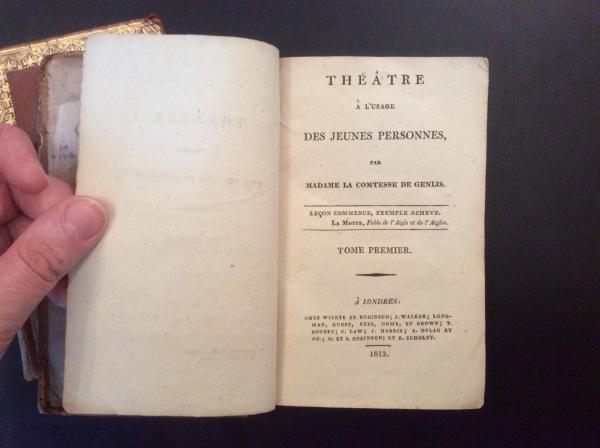
Elegant Extracts: or, Useful and Entertaining Pieces of Poetry. London: Printed for J. Johnson, etc., 1801. (Knight Family Collection, on deposit at Chawton House Library.)
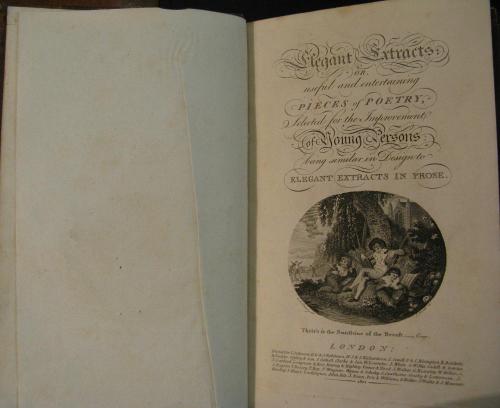 |
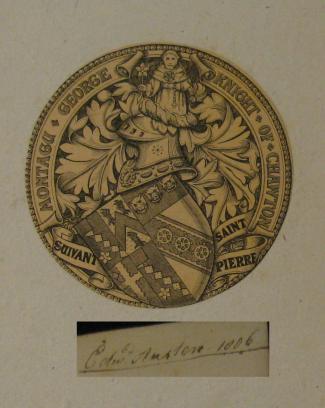 |
In Emma, Harriet Smith describes Mr. Martin’s reading aloud from Elegant Extracts: “‘very entertaining’” (28). Collections such as this one were very popular in the early nineteenth century. They were designed for the education of young people in particular. In this collection, selections from the King James Bible join selections from Shakespeare, Dryden, Milton, and Spenser, early eighteenth-century poets John Gay and Edward Young, and later eighteenth-century poets William Cowper and Charlotte Smith, among many others.
This copy is signed “Edwrd Austen 1806” and formed part of the collection at Godmersham Park. Edward could refer to Jane Austen’s brother Edward, later Knight, or his eldest son, Edward, born 1794, who inherited the estates Godmersham Park and Chawton House on his father’s death in 1852.
Oliver Goldsmith. The Vicar of Wakefield. Bath: Printed for J. Browne, 1804. (Knight Family Collection, on deposit at Chawton House Library.)
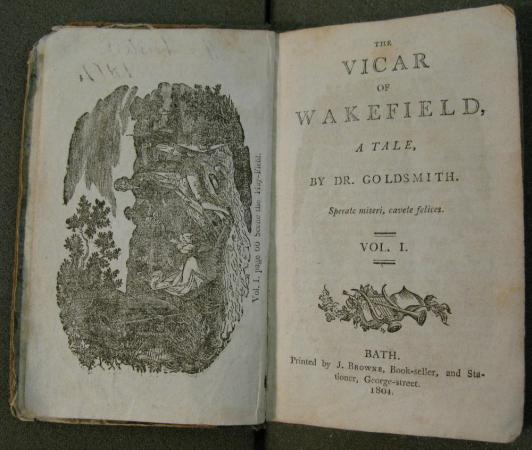 |
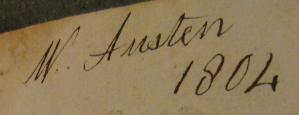 |
This novel, first published in 1766, remained popular throughout the nineteenth century. It can be read as both a sentimental novel and as a satire on the genre. That Mr. Martin has read it sets him out as no great lover of fashionable fiction: his reading is of the classics, and of useful works such as Agricultural Reports.
This copy bears the name “W. Austen, 1804.” Like the Elegant Extracts, it was part of the collection at Godmersham Park. William was Edward Austen, later Knight’s, fourth son. Born in 1798, he would have been a young child when this Bath edition was presented to him. Perhaps it was a gift from his grandparents and aunts, residing in Bath at the time.
Ann Radcliffe. The Romance of the Forest. First edition. London: Printed for T. Hookham and J. Carpenter, 1791. Chawton House Library Collection.)
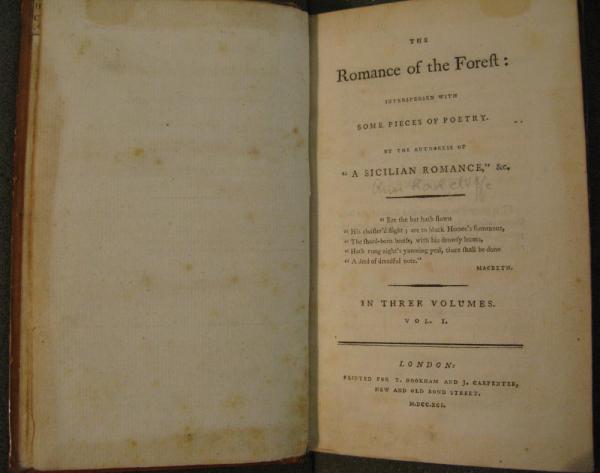
Radcliffe’s The Romance of the Forest and Regina Maria Roche’s The Children of the Abbey (1796) are both mentioned in Emma in relation to Robert Martin’s reading. Harriet Smith claims Mr. Martin “‘had never heard of such books before I mentioned them, but he is determined to get them now as soon as ever he can’” (28).
Jane Austen’s famous “defence” of the novel in chapter 5 of Northanger Abbey sees the narrator championing the realist novels of Frances Burney and Maria Edgeworth. The sentimental and Gothic fiction of authors like Radcliffe and Roche gets much shorter shrift. In Emma, these Gothic and sentimental works are the preferred reading of the somewhat silly Harriet and clearly set against the sound good sense and reading of Mr. Martin.
In the Exhibition Room
John Murray II: A leading light of Romantic-period publishing
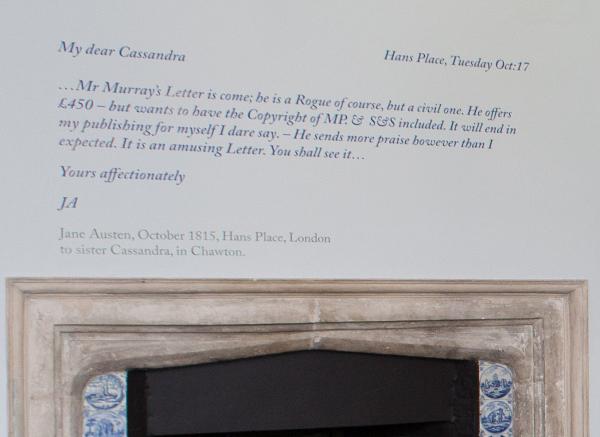
John Samuel Murray was born in Fleet Street, London, on November 27, 1778: an exact contemporary of Jane Austen’s. His father, John Murray, had set up as a bookseller in 1768, expanding the business to reprinting and finally publishing in his own right in the 1770s. John Murray II inherited his father’s business on the latter’s death in 1793. He was not yet fifteen. After his father’s death, John Murray II was apprenticed to his father’s assistant, Samuel Highley, and the business continued much as before, focusing primarily on the medical works that his father had become known for in the 1780s.
An accident in his youth had left John Murray II with sight in only one eye. But, as Samuel Smiles put it in his 1891 history, A Publisher and his Friends, “To a sculptor, the loss of the sight of one eye must have been a very formidable hindrance, but to a publisher of books, provided he have brains enough, the loss is not nearly so great” (1:32).

50 Albemarle
Certainly John Murray II seems to have been a remarkably astute and discerning businessman and critic, willing to take risks on the works he chose to publish and with a great sense of what might capture the public imagination—and tempt them to open their pocket books. He dissolved his partnership with Samuel Highley in late 1802, saying in early 1803 that “the obstacle which has hitherto prevented me from entering upon any works of merit is now removed.” From almost the moment of his break from Highley, Murray became one of the leading lights of Romantic-Period publishing. He established the Quarterly Review, the Tory literary journal and periodical, in 1809, and published a great many of the landmark texts of the period.
Murray’s residence at 50 Albemarle Street—where he lived from June 1812—saw him right at the center of literary life in London and, indeed, much further afield, since foreign authors and dignitaries took care to call on him too. In his drawing room, Murray entertained the most prominent literary figures of the day: Walter Scott met Lord Byron for the first time there in April 1815; the manuscript of Byron’s memoirs was burnt in Murray’s fireplace after the poet’s death in 1824.
Writing about this golden age in his preface to his 1891 A Publisher and his Friends, Samuel Smiles lists Murray’s intimate friends and correspondents: Sir Walter Scott, Lord Byron, Canning, Southey, the Disraelis, Campbell, Crabbe, Hallam, Croker, Milman, Washington Irving, Madame de Staël. The late nineteenth-century list is notable for containing several names now obscure to all but the specialist of the period. And it is notable, too, for its inclusion of only one woman writer: the great Franco-Swiss writer and thinker Germaine de Staël (1766-1817).
Yet Murray made his name—and his fortune—by publishing a great variety of women writers. His diverse lists include fiction, poetry, and a great deal of non-fiction. This section of our Emma at 200 exhibition situates Jane Austen alongside her female contemporaries also published by the House of Murray.
John Murray, Jane Austen, and the publishing of Emma
You will be glad to hear that every Copy of S.&S. is sold & that it has brought me £140—besides the Copyright, if that shd ever be of any value.—I have now therefore written myself into £250.—which only makes me long for more.
—Jane Austen to her brother Frank, from Chawton, 6 July 1813
[I]t is not settled yet whether I do hazard a 2d Edition [of Mansfield Park]. We are to see Egerton today, when it will probably be determined.—People are more ready to borrow & praise, than to buy—which I cannot wonder at;—but tho’ I like praise as well as anybody, I like what Edward calls Pewter too.
—Jane Austen to niece Fanny Knight, from London, 30 November 1814
Jane Austen’s first three novels—Sense and Sensibility (1811), Pride and Prejudice (1813), and Mansfield Park (1814)—were brought into production by Thomas Egerton, a London-based publisher specializing largely in military and political works. It is not entirely clear why, in 1815, Austen decided that a move away from Egerton for her fourth novel would be desirable. Several critics have suggestion that it must have something to do with his being unwilling to bring out a second edition of Mansfield Park in autumn 1814. Whatever the reason, it seems that Austen—increasingly willing to take risks and to experiment in her fiction—wanted to take risks and experiment with her publisher.
John Murray II—who had become Lord Byron’s publisher just three years previously—was just the person to take Emma on, position it for good reviews in the Quarterly Review and elsewhere, and pay generously for it. As Kathryn Sutherland has observed, the career trajectories of Murray and Austen in the mid-eighteen-teens are, with the benefit of hindsight, remarkably similar: “Austen was establishing herself as a new kind of fiction writer; Murray was in the vanguard of a new breed of publisher” (110).
Jane Austen—assisted by brother Henry—seems to have wanted to sell the copyright for Emma to Murray outright, just as she had done with the copyright of Pride and Prejudice, which had been sold to Egerton for £110 (rather than the £150 she had wanted). Austen knew all too well that Egerton had had the best part of that deal, and seems to have been determined to negotiate for a better one, as “the author of Pride and Prejudice.”
I wrote to Mr Murray yesterday myself. . . . I had a most civil one in reply. . . . He is so very polite indeed, that it is quite overcoming.—The Printers have been waiting for Paper—the blame is thrown upon the Stationer—but he gives his word that I shall have no farther cause for dissatisfaction. . . . —In short, I am soothed & complimented into tolerable comfort.
—Jane Austen to Cassandra Austen, from London, 24 November 1815
John Murray offered Austen £450 for the copyright of Emma, but wanted the copyright of Sense and Sensibility and Mansfield Park included. Austen and her brother Henry felt these terms to be unreasonable, and Emma was published on commission by John Murray, as was a second edition of Mansfield Park. This meant that Austen was responsible for all costs, but received all profit after costs: Murray was responsible for all distribution, and took only 10 per cent on sales.
Austen scholars and editors seem now to agree that Murray’s estimate of the value of three of Austen’s copyrights—Sense and Sensibility, Mansfield Park, and Emma—at £450 was very fair. As Jan Fergus points out, “Had she accepted his offer, she and her heirs would have made more money—and received it within a year, not (as it turned out) over a period of seventeen years, including the sale of all five remaining copyrights to the publisher Richard Bentley for £210 in 1832” (9). Understandably, Austen had gone for “pewter” as well as praise. Her gamble did not pay off. Exactly 2009 copies of Emma were printed and published on 23 December 1815. Sales started off well, but Murray’s stock books show that the greatest demand was in the first nine months. 539 copies were remaindered in 1820, at 2 shillings each.
John Murray, publisher, and his female friends
I have nothing new to do here so am reading a great deal of old unreadable stuff. I’ve got some of the sagas & an Icelandic Dictionary by way of light summer reading for the ladies. . . . I wish you would write to me & tell me what your literary friends are about.
—Maria Graham to John Murray II, from Scotland, June 1816
Samuel Smiles’s lengthy study of John Murray II, A Publisher and his Friends (1891), emphasizes his relationship with Lord Byron and Walter Scott in particular. Well into the twentieth century—and to an extent today—it was the relationship with the former that defined Murray II’s publishing career. “Mad, bad, and dangerous to know” were the words used by Lady Caroline Lamb of the poet. She and Lord Byron had a notorious affair in 1812, and Lamb wrote a thinly-disguised pen-portrait of herself and the poet in her 1816 novel Glenarvon (a work that, perhaps understandably, was not published by Murray!).
There is a group portrait imagining the April 1815 meeting between Lord Byron and Sir Walter Scott painted in 1850, in commemoration of an illustrious literary event. The painting shows an exclusively male gathering at 50 Albemarle Street. Murray’s “Four o’clock friends”—gatherings and afternoon tea with his writers—may have largely consisted of men.
Indeed, reading the letters to John Murray II in the Murray Archives at the National Library of Scotland gives a more nuanced picture of a publisher who was extremely supportive of the work of the women writers on his list. He sent them books, sought their advice on what to publish and their help with translating and reviewing, and published a great many women across a wide variety of genres—travel writing, poetry, cookery, and scientific writing, as well as novels. Some of the female-authored books on Murray’s lists also represented firsts. His 1804 publication of a translation of Stéphanie-Félicité de Genlis’s The Duchess of Valliere was the first novel to appear under the Murray imprint. Maria Rundell’s Domestic Cookery (1806) did a great deal to make his fortunes: 65 editions appeared between first publication and 1841, and he used the copyright of it as security for 50 Albemarle Street. Mary Somerville’s science writing was trailblazing, in a field that was of course traditionally seen as masculine. And Murray published radical women thinkers, tainted with French republicanism: both Germaine de Staël and Helen Maria Williams were called on by Murray, in both London and Paris, and he corresponded with both, as well as publishing their writings. Finally, Murray’s correspondence with Maria Graham—who translated for him, as well as published her important travel narratives with him—includes letters sent from both Scotland and Rio de Janeiro. The business of publishing was clearly an international one.
With hindsight, Murray must of course have regretted some of his publishing decisions. At the time he was negotiating with Scottish publisher William Blackwood to publish Susan Ferrier’s Marriage (1818), he passed up the work of one of her then unpublished female contemporaries.
The rejected novel? Mary Shelley’s Frankenstein.
Stéphanie-Félicité de Genlis. Duchess of La Vallière. An Historical Romance. By Madame de Genlis. Translated from the French. First edition. London: Printed for John Murray, no. 32, Fleet Street, 1804. (Chawton House Library Collection.)
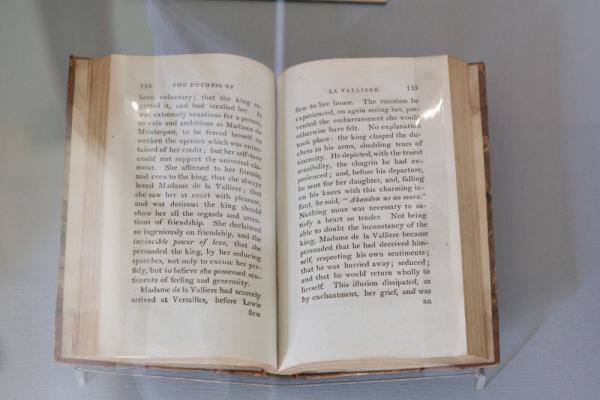
This historical novel tells the story of Louis XIV’s mistress Louise de la Vallière (1644-1710) and the French court at Versailles. It was the first female-authored fiction published by John Murray, appearing shortly after his separation from his business partner. It was presumably selected because Genlis already had a significant following in Britain: it could therefore be seen as a low-risk work that would sell. A June 1804 payment to a “Mr. Hall” recorded in the Murray ledger may identify the translator, about whom nothing else is known.
Maria Eliza Rundell. A New System of Domestic Cookery; Formed upon Principles of Economy. And Adapted to the Use of Private Families. London: Printed for John Murray, Fleet-Street; J. Harding, St. James’s Street; and A. Constable and Co., Edinburgh, 1807. (Chawton House Library Collection.)
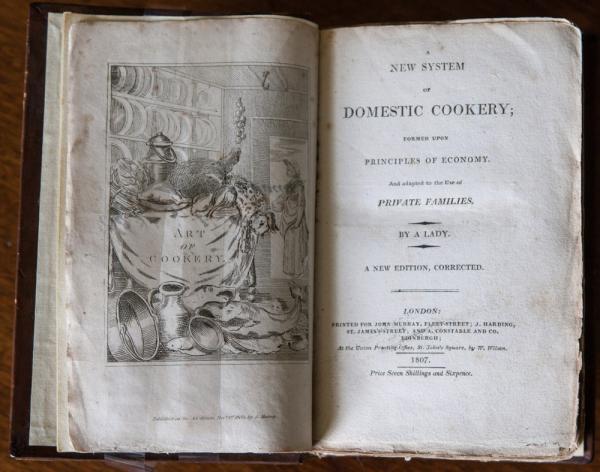
This work, first published in 1806, was responsible in large part for John Murray’s fortune. Rundell herself has been called “the original domestic goddess.” Her recipe for “water gruel” may have found favour with Jane Austen’s Mr. Woodhouse himself! This edition was corrected by Rundell. Her letters on the changes required survive in the Murray archive. John Murray used the copyright of Domestic Cookery and his quarter share in Scott’s Marmion as security for William Miller, from whom he bought 50 Albemarle Street and his publishing business in 1812. Domestic Cookery remained in print until the 1880s—a true nineteenth-century bestseller.
Letter from Maria Rundell to John Murray II, September 1808. (On loan from the John Murray Archive at the National Library of Scotland.)
The publisher and the author of Domestic Cookery were friends. This letter—sent from Rundell to Murray after he made a payment of £150 to her—attests to their cordial relationship in 1808. Rundell accepts Murray’s payment, but not before stressing that “I never had the smallest idea of any return for what I considered, & which really was a free gift to one whom I had long regarded as my friend.” Rundell later felt that, since her work was an obvious best-seller, she had not profited adequately from a copyright arrangement. After increasingly acrimonious exchanges—and legal action—Murray paid Rundell £2,100 and retained the right to publish her work.
Letter from Germaine de Staël to John Murray II, with proofs, 17 August 1813. (On loan from the John Murray Archive at the National Library of Scotland.)
The Franco-Swiss author Madame de Staël was John Murray’s most celebrated female author. She wrote this letter during an extended stay in London in 1813. At this time, Murray was preparing a new French edition of her 1810 work, De l’Allemagne, and an English translation, Germany. Staël took great care over the proofs and the translation of her work: this attentiveness can be seen clearly in several notes accompanying corrections, which can be read in the Murray archive. This note demonstrates their close and friendly relationship: “my dear Sir” is expected for dinner on Sunday.
Germaine de Staël. De L’Allemagne. Paris: H. Nicolle, à la Librairie Stéréotype, Rue de Seine, no 12, 1810. Ré-imprimé par John Murray, Albemarle Street, Londres, 1813.
_____. Germany. London: Printed for John Murray, Albemarle Street, 1813. (Both from the Chawton House Library Collection.)

By the time John Murray published these two works, Staël (1766-1817) was a European celebrity. She was known for her writings on Rousseau, on Marie-Antoinette’s trial, on Revolutionary politics more generally, and for two novels, Delphine (1802) and Corinne, or Italy (1807): the latter, at least, was read by Jane Austen. Staël was also notorious within Europe as a very public opponent of Napoleon Bonaparte: the French Emperor pulped De L’Allemagne mid-printing. Germany is an extended comparison between the northern and southern literary traditions, which favours the north—and, to an extent, heralds European Romanticism. To make sure that the popularity of Stael’s work was fully exploited and that the novel was brought out very quickly, John Murray employed three different printers, who printed a volume of De l’Allemagne each.
Letter from Maria Graham to John Murray, 2 January 1815. (On loan from the John Murray Archive at the National Library of Scotland.)
This lively letter from Maria Graham (1785-1842) gives an account of the preliminary negotiations between the woman who was to become the leading travel writer of the age and the publisher who became known for his list of travel narratives. Maria Graham expresses a desire to carry out a translation for Murray: “nothing would give me greater pleasure than to translate the said work both on your account & M. Rocca’s.” The Swiss-born Albert Jean Michel de Rocca was a lieutenant during the Napoleonic Wars and Germaine de Staël’s second husband. The work was eventually published in 1815 as Memoirs of the War of the French in Spain, translated from the French by Maria Graham.
Letter from Helen Maria Williams to John Murray II, 26 July 1815. (On loan from the John Murray Archive at the National Library of Scotland.)
This letter, from the poet, translator and polemicist Helen Maria Williams (1759-1827), was written to Murray while he was in residence in Paris in July 1815, post-Waterloo. With it, Williams includes sections of a manuscript “relating our last French adventures”: “I persuade myself that the said M.S. will be read with avidity in England, not because I have too good an opinion of its literary merit, but on account of the à propos of the subject—I should be pleased if it suited you to take it under your own wing.” Murray published her work later that year.
Helen Maria Williams. A Narrative of the Events which Have Taken Place in France. London: Printed for John Murray, Albemarle Street, 1816. Second edition. (Chawton House Library Collection.)

First published by Murray in 1815, Helen Maria Williams’s Narrative was always destined to attract a great many readers in Britain, as an account from a British citizen—long resident in France—on the fall of Napoleon. Williams had written in praise of the French Revolution in her Letters Written in France in the Summer of 1790, but her view of Napoleon is far from favourable. In fact, Williams sees the Emperor as an oppressive and arrogant tyrant and the Duke of Wellington as a unique leader in Europe.
Letter from Maria Graham to John Murray, 9 February 1816. (On loan from the John Murray Archive at the National Library of Scotland.)
This letter is one of the earliest first-hand accounts of a reading of Emma. There is a great deal of archival evidence that John Murray shared books with his authors, circulating new publications to them. Here, Maria Graham’s thoughts on Emma damn the novel with faint praise:
. . . as I was not allowed any stout reading I was very glad of something new that was light. I am very well pleased with Emma not that I think it equal to Pride and prejudice but it quite belongs to that class of innocent & lively novels [in] which the authoress so particularly excels.
Letter from Felicia Hemans to John Murray, June 1816. (On loan from the John Murray Archive at the National Library of Scotland.)
Felicia Hemans (1793-1835) was one of the most popular poets of the nineteenth century. Today, she is best known for “The Homes of England,” in which the phrase “stately home” first appears and “Casabianca,” which has the opening line “The boy stood on the burning deck.” This letter was written as she prepared to work on a new poem and documents several of the works published by Murray that she has been consulting. The topic of the poem was, broadly speaking, the Elgin Marbles: the still-controversial Parthenon marbles, purchased by the British Government in 1816 and on display in the British Museum. Hemans’s Modern Greece was published anonymously by Murray in 1817.
Letter from William Blackwood to John Murray, 4 March 1818. (On loan from the John Murray Archive at the National Library of Scotland.)
John Murray was extremely well-connected within the world of publishing. Frequently, publications were collaborative ventures. Here, the Edinburgh-based Blackwood writes of a new work of fiction, Marriage: “I consider it a work likely to make some noise, and if on giving it a glance you feel inclined to interest yourself in its success, I shall be happy to give you the charge of it in London.” William Blackwood and Sons was an Edinburgh institution, publishing Blackwood’s Magazine between 1817 and 1980—a Tory rival to the Whig Edinburgh Review, published between 1802 and 1929. Relations between Murray and Blackwood were frequently strained, but Marriage was published, and a success.
Susan Ferrier. Marriage, a Novel. First edition. Edinburgh: William Blackwood, Prince’s Street; London: John Murray, Albemarle-Street, 1818. (Chawton House Library Collection.)

Susan Ferrier’s Marriage was her first novel, published anonymously at her emphatic insistence. Blackwood’s letter to Murray is adamant that the identity of the author cannot be disclosed. In 1816, when Marriage was already fully drafted, Ferrier wrote on her reading of Emma: “I have been reading ‘Emma,’ which is excellent; there is no story whatever, and the heroine is no better than other people; but the characters are all so true to life, and the style so piquant that it does not require the adventitious aids of mystery and adventure.” Susan Ferrier’s own novels are often compared to Austen’s and contain less “mystery and adventure” than those of some of her contemporaries.
Letter from Maria Graham to John Murray, 17 September 1824. (On loan from the John Murray Archive at the National Library of Scotland.)
With this letter—from the exotic location of Rio de Janiero—John Murray’s circle of female acquaintances broadens out beyond Europe. Here, Maria Graham, working as tutor to the young princess, is depending on Murray to keep her informed of literary dealings back in her homeland: “I beg as a special favour you will write to me some times & tell me of the world of authors and books I fear I shall scarcely have much of the same kind to send in return but what I have shall be at your service.” And she takes care to enquire of the sales of her own books.
Maria Graham. Journal of a Voyage to Brazil, and Residence There, during Part of the Years 1821, 1822, 1823. London: Printed for Longman, Hurst, Rees, Orme, Brown, and Green, Paternoster Row; and John Murray, Albemarle Street, 1824. (Chawton House Library Collection.)

Maria Graham wrote accounts of travelling in India, Rome, and Chile. In this work, her pioneering experiences as a woman traveller in Brazil document the changes in the country from a Portuguese colony to an independent nation. Her comments on slavery, on politics, and on the role of the British in South America more generally are fresh and always engaging. In publishing this work, John Murray clearly recognized that a female perspective on the country would find readers.
In the Oak Room
Music, dancing, painting and French: Female accomplishment and Emma

Mrs. Goddard was the mistress of . . . a real, honest, old-fashioned Boarding-school, where a reasonable quantity of accomplishments were sold at a reasonable price, and where girls might be sent to be out of the way and scramble themselves into a little education, without any danger of coming back prodigies.
—Emma (21)
 The exhibits in this room—which served as the ladies’ withdrawing room during Jane Austen’s own time in Chawton—focus on female accomplishment in the late eighteenth and early nineteenth centuries. It was also host to a collaborative embroidery project, the Great Lady’s Magazine Stitch Off, the focus of a (video) filmed at Chawton House Library during the exhibition, as well as a project (blog) (Batchelor).
The exhibits in this room—which served as the ladies’ withdrawing room during Jane Austen’s own time in Chawton—focus on female accomplishment in the late eighteenth and early nineteenth centuries. It was also host to a collaborative embroidery project, the Great Lady’s Magazine Stitch Off, the focus of a (video) filmed at Chawton House Library during the exhibition, as well as a project (blog) (Batchelor).
The question of the acquiring of superficial and beautiful “accomplishments” rather than a solid “education” was a hotly debated one throughout Jane Austen’s own lifetime, and it is certainly a theme in Emma itself. Mrs. Goddard’s school “sells” accomplishments, and two of the most famous governesses in early nineteenth-century fiction—Mrs. Weston and Jane Fairfax—appear in the novel. Indeed, Jane Fairfax’s dark thoughts on the “‘Offices for the sale—not quite of human flesh—but of human intellect’” in conversation with Mrs. Elton demonstrate that her feelings on being forced to become a governess are ambivalent at best (325). Attitudes towards women’s work—or at least the work available to genteel women—are complex in the period, and Jane Austen seems to have shared her character’s anxieties. Of the governess at Godmersham Park, Miss Allen, she wrote to her sister, Cassandra, on 30 April 1811: “I like your opinion of Miss Allen much better than I expected, & have now hopes of her staying a whole twelvemonth.—By this time I suppose she is hard at it, governing away—poor creature! I pity her, tho’ they are my neices.”
A great many female accomplishments are on display throughout Emma. Mrs. Goddard’s parlour is “hung round with fancy-work” (21), that is, decorative needlework and embroidery. Emma paints landscapes and flowers, and she has attempted—but never finished—various portraits. Jane Fairfax is a highly accomplished woman, excelling at the piano in particular. Mrs. Elton, in a supremely comic episode, expresses a desire to “‘establish a musical club’” in Highbury, since “‘without music, life would be a blank to me’” (299, 298). Harriet Smith—with Emma’s assistance—is “collecting and transcribing all the riddles of every sort that she could meet with, into a thin quarto of hot-pressed paper, made up by her friend, and ornamented with cyphers and trophies” (74). Time, in rooms like these in the early nineteenth century, may have weighed very heavily on the inhabitants’ hands.
Commonplace Book, c. 1830, part of the Barrett papers. (Family papers of Simon Downing, on deposit at Chawton House Library.)

This “drawing book” has been collated in a scrap book style. It contains beautiful paintings of flowers; poetry by eighteenth-century and Romantic-Period authors such as Cowper, Thompson, Wordsworth, Hemans, and Byron; and music.
Enigma, written by Stéphanie-Félicité de Genlis. (On loan from the University of Aberystwyth, Wales.)

Harriet Smith’s collection of riddles and charades plays a prominent role in the misunderstood “courtship” of Mr. Elton and leads to a comic moment when Mr. Woodhouse misremembers “Kitty, a fair but frozen maid” (84). The latter could be found in The Poetical Works of David Garrick (1785) and had a range of more or less scurrilous “solutions.” There is no suggestion in Emma that Harriet’s collection of riddles contained French enigmas. But it is certainly the case that young women of the period composed and collected French verse. The Lady’s Magazine regularly held competitions for their readers to submit poetry in French for publication.
Binder’s volume of printed keyboard and harp music, c.1780-c.1815. (On loan from the private collection of Richard Jenkyns.)
The first flyleaf of this collection of music is signed “Cass. Elizth Austen” (Jane Austen’s sister, Cassandra Elizabeth Austen [1773-1845]). The first two flyleaves are watermarked 1812. The title page includes a blue ink stamp, “Chawton House, Alton, Hants.”

The volume includes printed editions of solo keyboard and harp music, published between c.1780 and c.1815, with the majority published c.1805-1810. Among this music is “Robin Adair” an Irish folk tune, named in Emma as the tune Jane Fairfax plays after the arrival of her Broadwood piano, while Frank and Emma speculate on its sender.
In the Long Gallery
Emma in contemporary culture and in translation

ELTON: Alright! You know, I don’t get you Cher. I mean, you flirt with me all year.
CHER: As if! I have been trying to get you together with Tai.
ELTON: Tai?! Why would I go with Tai?
CHER: Why not?
ELTON: Why not? Why not?! Don’t you even know who my father is?—Amy Heckerling’s Clueless, 1995
Amy Heckerling’s Clueless (1995) transforms Emma Woodhouse into Cher Horowitz, a spoiled California teenager who loves makeovers as well as matchmaking; Rajshree Ojha’s Aisha (2010) gives us a Bollywood version, inspired by Cher; the YouTube series Emma Approved (2013-2014) is determined in its twenty-first century America setting. All these Emmas transform the place, characters, and tone of Austen’s novel in creative and amusing ways.
Such retellings have a long history—perhaps much longer than most readers of Emma today realize. Nineteenth- and early twentieth-century translations adapted the provincial English setting to suit the expectations of their readers, and foreign publishers advertised the contents of the novel with wildly diverse book jackets and descriptions. Prequels, sequels, and stage and print adaptations and reimaginings appeared early in the twentieth century. Austen’s Emma has long inspired creative retellings: just some of them are on display here.

Emma by Jane Austen. Romance Comics
Letter from Alberta Burke to R. W. Chapman, 13 November 1953. (On loan from Goucher College Library, Baltimore.)
The identification of translations into foreign languages was frequently an amateur pursuit. Alberta Burke, an American Austenite, who amassed an extraordinary collection of Austen-related material in mid-twentieth century Baltimore, collected translations whenever she travelled abroad. Here, she informs the Austen scholar R. W. Chapman of some translations of Emma of which he is unaware.
Letter from David Gilson to Alberta Burke, 31 March 1969. (On loan from Goucher College Library, Baltimore.)
The Austen bibliographer David Gilson and Alberta Burke carried out a lengthy correspondence on all things Austen-related. Here, Gilson tells an amusing tale of trying to locate Chinese translations of Austen’s novels and identifies a common confusion between Austen and the Brontë sisters! “I once enquired at Collet’s Chinese Bookshop in London for Chinese translations and was told that all Jane Austen’s novels had been translated into Chinese, including Jane Eyre and Wuthering Heights—so this must be a common confusion.” More information about foreign language translations can be found in Dow, “Uses of Translation.”
In the Staircase Hall
Emma at 200; Shakespeare at 400

Places are secured at Drury Lane for Saturday, but so great is the rage for seeing Keen that only a 3d& 4th row could be got. As it is in a front box however, I hope we shall do pretty well.—Shylock.—A good play for Fanny. She cannot be much affected I think.
—Jane Austen to her sister, Cassandra, from London, 2-3 March 1814
Shortly after she had begun to work on the novel that would become Emma>, Jane Austen took a trip to London to stay with her brother Henry. As ever, the theater held many attractions for her. She was among the first audiences to see the actor Edmund Kean (1737-1833) play Shakespeare’s Shylock—a role that made the actor’s reputation and fortune and did a great deal to restore the fortunes of the Drury Lane theater.
In this 400th anniversary year of Shakespeare’s death, it is useful to reflect on his celebrity 200 years ago, when Jane Austen and her family went to see his plays performed. Shakespearean actors were the celebrities of the eighteenth century. The great actor and playwright David Garrick (1717-1779) did a great deal to create Shakespeare as England’s national poet. Actors and actresses became known for their performances in certain roles, or in character types. Dorothy Jordan (1761-1816) was known for her breeches roles; Sarah Siddons (1755-1831), for her tragic heroines; the actress and author Mary Robinson (1756/58-1800), mistress of the Prince Regent, was most famous for playing Perdita in A Winter’s Tale, a role commemorated in the portrait by Hoppner that hangs in our Great Hall.
The critic Jocelyn Harris has argued that—with its star-crossed lovers and misunderstandings—Austen’s Emma reimagines Shakespeare’s A Midsummer Night’s Dream. As Henry Crawford puts it in Austen’s Mansfield Park, “‘Shakespeare one gets acquainted with without knowing how. It is part of an Englishman’s constitution. . . . [O]ne is intimate with him by instinct’” (390-91). Shakespeare certainly inspired Jane Austen and her contemporaries, as the books in this section of the exhibition demonstrate.
The Works of Shakespeare, Volume the First. London: Printed for J. Tonson, 1735. (Knight Family Collection, on deposit at Chawton House Library.)

These volumes of The Works of Shakespeare all come from the Knight collection of books held here at Chawton House Library. They have belonged to the family for many generations, and were once held in the library at Godmersham Park in Kent.
Library Catalogue, Godmersham Park. (1818. Knight Family Collection, on deposit at Chawton House Library.)
This manuscript catalogue of the library at Godmersham Park, the main residence of Austen’s brother Edward, was presumably started in 1818, the date embossed on the cover. However, books are listed that were published as late as the early 1840s, so clearly the catalogue was maintained and updated over a number of years. It is open at the page that includes The Works of Shakespeare.
The Works of Shakespeare, Volume the Second. London: Printed for J. Tonson, 1735. (Knight Family Collection, on deposit at Chawton House Library.)

There does seem to be a something in the air of Hartfield which gives love exactly the right direction, and sends it into the very channel where it ought to flow.”
The course of true love never did run smooth—
A Hartfield edition of Shakespeare would have a long note on that passage.”
—Emma Woodhouse, Emma (79-80)
This collected works of Shakespeare is one of three separate editions recorded in the Godmersham Park Library catalogue of 1818, attesting to the importance of the author to the English country house library. The scribe at Godmersham Park incorrectly recorded the date of publication as 1635, which would have made it almost contemporary with Shakespeare’s First Folio, published 1623.
Plays Never before Printed. Written by the Thrice Noble, Illustrious and Excellent Princesse, the Duchess of Newcastle. First edition. London: Printed by A. Maxwell, 1668. (Chawton House Library Collection.)
Margaret Lucas (1623?-1673) was born in Essex into a Royalist household: she was maid of honor to Queen Henrietta Maria and followed her into exile in France in 1644. There she met her husband, William Cavendish, Marquess of Newcastle upon Tyne. In 1664, Margaret Cavendish published a critical essay on Shakespeare. It was the first extended commentary on the playwright. So began a long tradition of women’s critical responses and commentary on his works in the long eighteenth century. On display here is a first edition of Cavendish’s Plays, Never Before Printed from 1668. Her own drama frequently transforms plots found in Shakespeare: The Convent of Pleasure in this collection uses Love’s Labours Lost as its source text.
Shakespear Illustrated: Or the Novels and Histories, on which the Plays of Shakespear are Founded. In two volumes. By the author of the Female Quixote. First edition. London: Printed for A. Millar, 1753. (Chawton House Library Collection.)

Mary Robinson
Charlotte Lennox (1730-1804?) was a novelist and translator, best-known today for her The Female Quixote, or The Adventures of Arabella (1752), a work that Jane Austen read and enjoyed. Shakespear Illustrated was a pioneering attempt to translate and summarize Shakespeare’s major sources in French and Italian romances. Lennox was certainly not overawed by the power of Shakespeare’s reputation, finding him to be an author lacking in several crucial qualities, including invention. David Garrick disliked her criticisms of the great man: “In the Whole, I imagin’d that you had betray’d a greater desire of Exposing his Errors than of illustrating his Beauties.”
This volume is open at “The fable of the Winter’s Tale.” Mary Robinson (1758-1800) played the character Perdita in a command performance on December 3, 1779: four days later, the Prince of Wales, the future George IV, claimed to be passionately in love with her.
An Essay on the Writings and Genius of Shakespear, Compared with the Greek and French Dramatic Poets. Third edition. London: Printed by H. Hughs, 1772. (Chawton House Library Collection.)

Elizabeth Montagu (1718-1800) was an important patron of the arts, and founding member of the Blue Stockings Society of England. Her essay on Shakespeare is a patriotic defence of the playwright and his English admirers against perceived French attacks. Montagu argues for Shakespeare’s originality and natural genius, and she champions English drama above the style of theater that dominated across the Channel. First published anonymously in 1769, the run of 1,000 copies quickly sold out.
The Morality of Shakespeare’s Drama Illustrated. By Mrs. Griffith. First edition. London: Printed for T. Cadell, 1775. (Chawton House Library Collection.)

The playwright, novelist, and translator Elizabeth Griffith (1727?-1793) was born into a theatrical family in Dublin, and educated in French and English. She translated prolifically, including French memoirs and plays. She wrote the critical commentary on display here in part in response to Elizabeth Montagu’s Essay, and to “defend” Shakespeare from the French philosophe Voltaire, who claimed not to understand the English bard’s significance. Griffith excerpted passages from Shakespeare and commented on them to attest to his national—and international—significance.
Memoirs of the Late Mrs. Robinson, Written by Herself. With some Posthumous Pieces. First edition. London: Printed for R. Phillips, 1801. (Chawton House Library Collection.)
Mary Robinson was a writer, actress, and famously, mistress to the Prince Regent, the future George IV. She published her first collection of poetry in 1775 and went on to associate with influential members of society such as Georgiana, 5th Duchess of Devonshire, and David Garrick. The latter helped establish her acting career, and she became famous for playing many of Shakespeare’s heroines, especially for her role as Perdita in The Winter’s Tale.
In the Lower Reading Room
 Readers’ responses in the nineteenth century
Readers’ responses in the nineteenth century
I am so glad you like what you have read of “Emma,” and the dear old man’s “gentle selfishness.”—Was there ever a happier expression?—I have read no story book with such glee, since the days of “Waverley” and “Mannering,” and, by the same Author as “Emma,” my prime favorite of all modern Novels “Pride & Prejudice.”
—Sarah Harriet Burney to Charlotte Francis Barrett, 1 March 1816
Sarah Harriet Burney (1772-1844) was a novelist herself, and half-sister of the more famous Frances Burney (1752-1840)—an author Jane Austen admired greatly. In her March 1816 letter, Sarah Harriet Burney compares Austen’s novels to Walter Scott’s recent publications: Waverley (1814) and Guy Mannering or The Astrologer (1815). The comparison is an interesting one, not least because Scott’s anonymous review in the Quarterly Review appeared in the very same month. Scott had responded to John Murray II’s invitation to “dash off an article on Emma” for the Quarterly. Murray, in this letter, noted that Emma “wants incident and romance, does it not?” And certainly, a great many readers in 1816 felt the same way, including the friends and family canvassed by Austen, whose “Opinions of Emma” she recorded in manuscript.
Outside Austen’s immediate circle, Susan Ferrier, whose 1818 Marriage was published by John Murray, found Emma “excellent,” but pointed out there was “no story whatsoever.” Maria Edgeworth—to whom Jane Austen sent a copy—also felt that “there is no story in it.” And yet Scott, in his article for the Quarterly, recognized that Emma was a new style of novel, very unlike what he was later to call his own “Big Bow-wow strain” of fiction. Indeed, Alresford-born author Mary Russell Mitford, writing in 1816, felt Emma was “the best, I think, of all her charming works.”
Throughout the nineteenth century, many were inspired by Emma and Jane Austen more generally. Catherine Gore—famous for her novels of fashionable life in the 1820s and 1830s—has a trilogy of novels inspired by Emma. Mothers and Daughters (1831), Pin Money (1831), and Mrs. Armytage: or, Female Domination (1836) owe direct—and acknowledged—debts to Emma. As Edward Copeland has observed, by the mid-nineteenth century “Emma had become the novel most employed as the touchstone of Austen’s excellence, cited specifically or treated implicitly as her ‘best’” (81). Some, however, failed to see the attraction. Charlotte Brontë’s letter to her publisher W. S. Williams gives Emma, and its author, short shrift.
Sir Walter Scott. Review of Emma. Quarterly Review (October 1815): Art. IX, 188-201. (For images of the entire essay, visit the British Library’s website.)
This review, which appeared anonymously in 1816, was requested by John Murray in a letter of 25 December 1815: “Have you any fancy to dash off an article on “Emma”? It wants incident and romance, does it not?” Scott had already published two novels by this stage, and he was a frequent reviewer for the Edinburgh Review and the Quarterly Review. His sensitive review of Emma’s merits was the first lengthy appraisal of her fiction—indeed the first lengthy appraisal of any fiction by another major writer of the period.
Jane Austen’s response to Scott’s review, in a letter to John Murray, was pleasingly laconic: “The Authoress of Emma has no reason I think to complain of her treatment in it—except in the total omission of Mansfield Park.—I cannot but be sorry that so clever a Man as the Reviewer of Emma should consider it as unworthy of being noticed” (1 April 1816).
Letter from Maria Edgeworth to an acquaintance of the Comte de Stendhal, 17 March 1818. (Chawton House Library Collection.)
Maria Edgeworth (1768-1847) was more famous in her lifetime as a novelist than Austen was. Austen sent Edgeworth a copy of Emma, but Edgeworth was unimpressed: “There is no story in it.” She turned to Frances Jacson’s Rhoda (1816), a work that she considered much better—50% better—than Emma. Here, Edgeworth writes to an unknown correspondent, on a work sent to her by the French novelist Stendhal, Henri Beyle (1783-1824), celebrated for his Le Rouge et le Noir (1830). Edgeworth often admired continental fiction more than the work of her English contemporaries. But the English novel was taking a new path, one that would leave Edgeworth’s fiction behind as the nineteenth century progressed.
Letter from Charlotte Brontë to W. S. Williams, 12 April 1850. (On loan from the Huntington Library, California.)
Charlotte Brontë (1816-1855) was born in the year that Austen’s Emma was published. In this letter to the literary editor of Smith Elder publishers, we see someone now recognized as the leading English woman writer of her generation commenting on the leading woman writer of the previous generation. But the comments cannot be read entirely favourably! Indeed, Brontë is somewhat baffled by Austen’s appeal. She seems, throughout her writing career, to be defining her own work against Austen’s in some way: she is more admiring of her French contemporary George Sand’s passionate fiction than the “genteel” lives portrayed in Emma.
![]()
After viewing these final items in the lower reading room, visitors could take tea in our Old Kitchen, where we promised our pies were all apple pies: no unwholesome preserves at Chawton House Library! From there, they could venture out into the garden, where strawberry beds awaited in the Walled Garden (containing three varieties), and warnings not to advance beyond the shrubbery were strategically placed by our Garden Manager, Andrew Bentley. And although we were sad to dismantle the exhibition when the end of September came, we know that 2017 will bring new worlds to explore.
 |
 |
 |
ACKNOWLEDGMENTS
As curator of the exhibition, I was extremely grateful for the support of our librarian, Dr. Darren Bevin, who—with his team of volunteers—assisted with all aspects of the exhibition preparation, and my colleagues Helen Thirlway, who designed the exhibition interpretation boards, and Keith Arscott—now retired—whose successful funding bids enabled us to purchase the display cases that made the whole thing possible.
Richard Jenkyns, Chairman of the Jane Austen Society of the U.K., and Simon Downing, lent family papers for the duration of the exhibition. Curators from libraries in the U.K., the U.S., and Germany helped tremendously with loan items: from loan agreements to the complicated logistics involved with getting rare material overseas and through customs. I would like to record thanks to the librarians at King’s College Cambridge, the University of Göttingen Library in Germany, the University of Aberystwyth in Wales, Goucher College in Baltimore, and the Huntington Library in California. Particular thanks must go to David McClay, Murray curator at the National Library of Scotland in Edinburgh, whose enthusiasm for Murray’s other women matched my own. And finally, thank you to JASNA members, and to all the other Austen societies and individuals who donated generously to the exhibition: without you, it would not have been possible.
